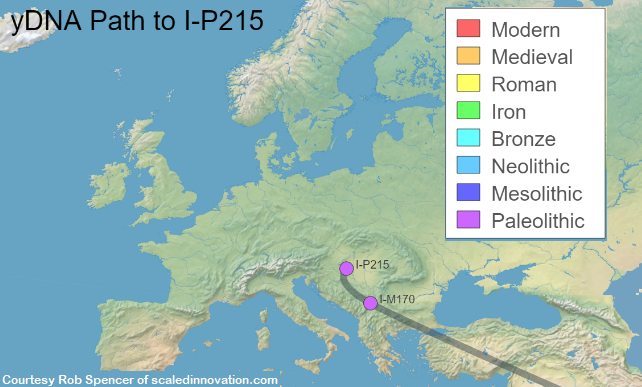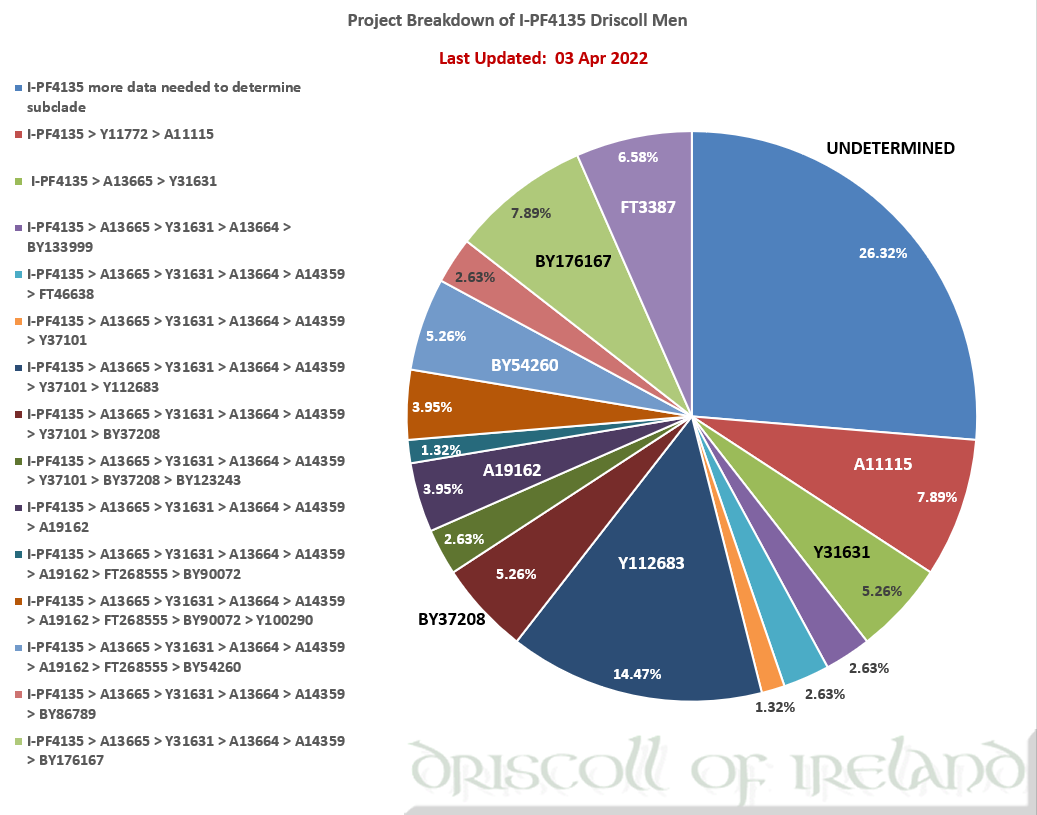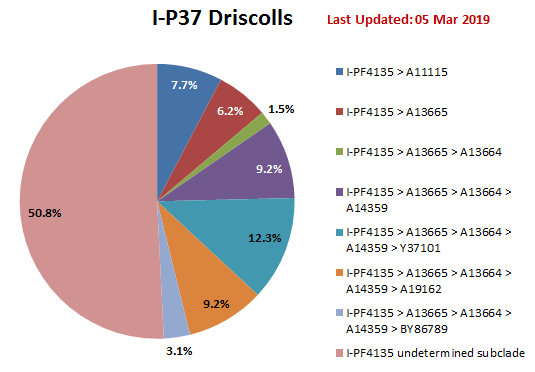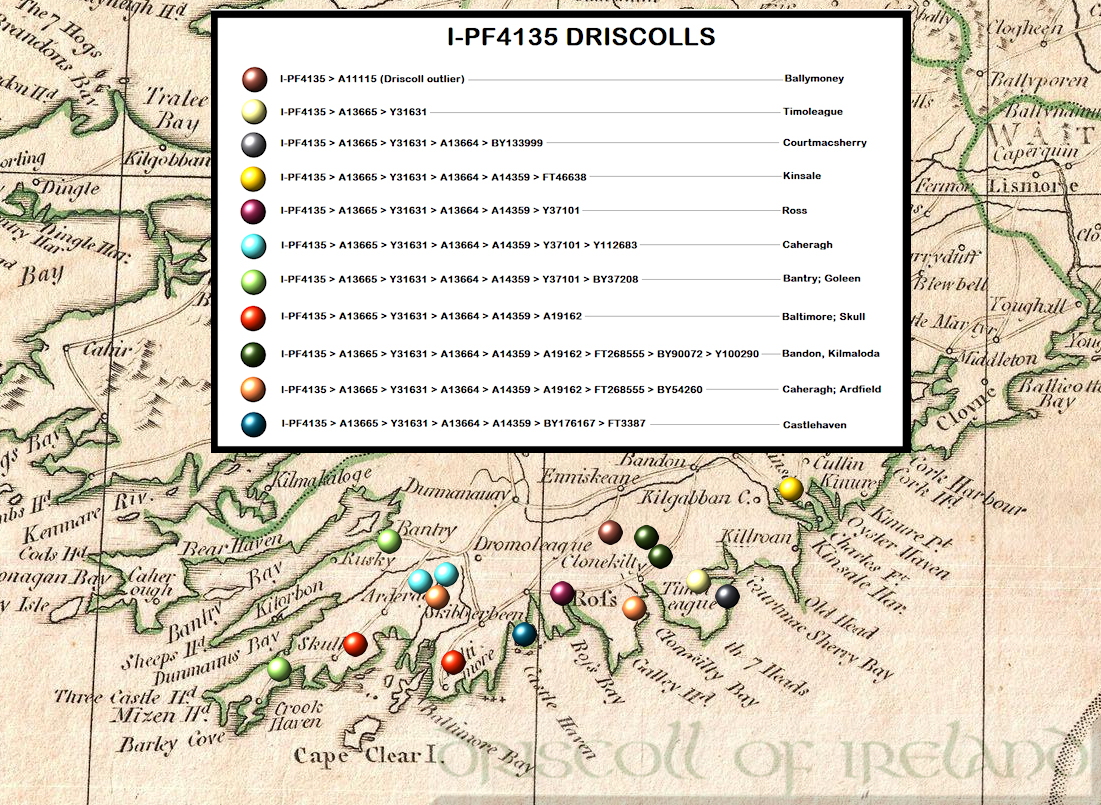Click the image below to start/stop the slideshow.
 Click on image to start/stop slideshow.
Click on image to start/stop slideshow.
Haplogroup I has a considerably older presence in Europe than its Neolithic competitor, R1b. It accounts for roughly 20% of Europe's male population. Unlike R, Group I is almost entirely exclusive to Europe (or historical European colonies). It was likely present in Europe from the Paleolithic and its subclades reached Ireland before R1b. Some posit that our Driscoll Isles A ancestors arrived in what is now the UK many thousands of years ago, when the North Sea was still land. They then later moved into Ireland.
The slideshow illustrates the approach of this SNP lineage toward the British Isles. I-P37 is a Paleolithic age mutation; I-L161 is a Mesolithic era mutation. It tends to jump around a little in the slides. There is a substantial knowledge gap through the Neolithic. Then I-PF4135, which could well have emerged in Ireland, falls into the Bronze Age. Geographic precision in the slideshow within Ireland is lost from that point. The slideshow ends in one line of descendancy. We are still missing so much information!
I2 P215 I2a CTS2257 I2a1 L460 I2a1a P37.2 I2a1a2 M423 I2a1a2a L161/S2675 I2a1a2a1 S2639 I2a1a2a1b Y12072/BY1749 I2a1a2a1b1 PF4135 |
Our project Driscolls under this haplogroup have a predicted haplogroup of I-P37 when they take a Y STR test. Starting from parent haplogroup I2, the mutation progression from there through I-P37 to I-PF4135 is as shown on the left. The I2 mutation is estimated to have formed about 30,000 B.C.E. Further downstream, SNP formation dates are around 19,000 B.C.E. for I-P37, 9400 B.C.E. for I-L161, and 1100 B.C.E. for I-PF4135. These numbers were from scaledinnovation.com, at the time this page was published. |
These times are estimates. I-PF4135 descendants were very likely in Ireland and even in Munster prior to the zenith of the Corca Laidhe kingdom, occurring roughly 200-300 C.E. For now, our working theory is that the ancestor(s) of our I-PF4135 Driscolls were living in the territory, and eventually took the Driscoll name.
I2 Isles A project members are advised to join the I2a project and the I-L161 (I2a-Isles) Project. About 59% of Driscoll project members fall into this group.
Jack Danel's I-L161 reconstruction is a fun and informative read.
The chart below shows that, as of early 2022, about 26% of I-PF4135 Driscoll project participants have not done sufficient yDNA testing to determine the subclade. (Sometimes, the project administrator guesses the subclade for those who have not done advanced Big Y testing.) Compared to 2019 (three years prior), the number of members with undetermined subclades is down from about 51%. We are now showing at least 14 subclades, compared to 7 in 2019.


Our map of County Cork here pins terminal SNPs to known ancestral locations.
Refer to our analysis page for details of the subclade structure of I-PF4135 and time estimates.
Not all I-PF4135 Driscoll branches have been traced to a location in Ireland on the map below, and not all Driscoll project members in known branches are drawn on the map.

| Driscoll at FTDNA | DNA Portal | Project Pedigrees |
| See ABOUT for website information. | ||
| Copyright © 2010-2024 driscoll.dnagen.org. All rights reserved. | ||


